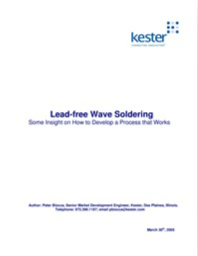Lead-free Wave Soldering
As lead-free gains momentum, many engineers are striving to set-up a wave solder process that maintains production yields but also offer reliable assemblies. Much has been written on these topics in the past 5 years.
Less confusion does exist today about alloy choices available to replace leaded solders, however many are struggling with their successful implementation. Once the lead-free alloy is selected, a solid understanding of its chemical and physical properties is required to enable reliable soldering.
Download this whitepaper to learn more.
Read More
By submitting this form you agree to Kester Inc contacting you with marketing-related emails or by telephone. You may unsubscribe at any time. Kester Inc web sites and communications are subject to their Privacy Notice.
By requesting this resource you agree to our terms of use. All data is protected by our Privacy Notice. If you have any further questions please email dataprotection@techpublishhub.com
Related Categories: Components, cooling


More resources from Kester Inc

How do you ready a solder pot for lead-free solder?
It is important to first insure the solder is lead-free solder compatible. High tin alloys tend to leach iron causing dissolution of iron and solde...

How do you create a RoHS Compliancy-Lead-free Roadmap?
When a company begins the transition to lead-free it impacts the whole organization. The cost of transition will vary and depends on the number of ...

THE NATURE OF WHITE RESIDUE ON PRINTED CIRCUIT ASSEMBLIES
White residue remaining after cleaning circuit board assemblies can be caused by a variety of chemicals and reactions. Rosin and water-soluble flux...
